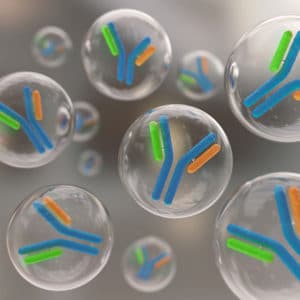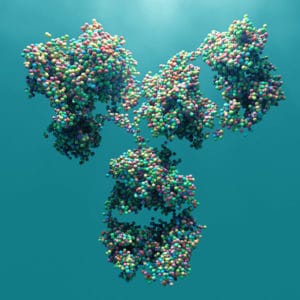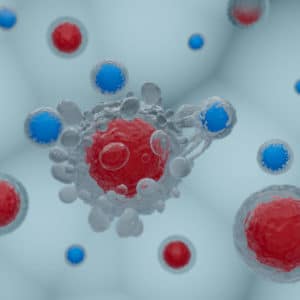Antibody & Other Therapeutic Formats
Therapeutic Discovery Platforms
 The generation of monoclonal antibodies to source the drug discovery pipeline has become highly commoditized, increasing demand for high throughput analytical tools to assess the output of antibody discovery platforms. Whether antibodies are sourced from in vivo or in vitro methods, knowledge of their functional diversity, in terms of their binding kinetics, affinities and epitope coverage towards their specific target are key parameters used in evaluating them and identifying potential therapeutic candidates/leads. Next generation sequencing and advancement in computational biology have enabled the development of “smart” libraries, spawning a diversity of companies with their own antibody discovery platform claiming to deliver antibody libraries with enhanced and desirable properties, such as high affinity, broad epitope coverage, or exquisite selectivity.
The generation of monoclonal antibodies to source the drug discovery pipeline has become highly commoditized, increasing demand for high throughput analytical tools to assess the output of antibody discovery platforms. Whether antibodies are sourced from in vivo or in vitro methods, knowledge of their functional diversity, in terms of their binding kinetics, affinities and epitope coverage towards their specific target are key parameters used in evaluating them and identifying potential therapeutic candidates/leads. Next generation sequencing and advancement in computational biology have enabled the development of “smart” libraries, spawning a diversity of companies with their own antibody discovery platform claiming to deliver antibody libraries with enhanced and desirable properties, such as high affinity, broad epitope coverage, or exquisite selectivity.
Carterra’s LSA enables a highly parallel interaction analysis to be performed on large antibody libraries, up to 384 binding interactions at once, accelerating the determination of binding kinetics, affinities and epitope specificities. This antibody discovery platform delivers a highly comparative analysis of clones, increasing confidence in the comparison and facilitating the benchmarking of libraries against one another by merging them into the same experiment. Of particular note, the Carterra LSA enables comprehensive epitope binning studies to be performed on up to 384 antibodies per experiment, allowing for a full 384 x 384 interaction analysis matrix in an unattended run, supported with sophisticated and intuitive data analysis software. The epitope binning picture gains depth, resolution, and nuance with the size of the antibody panel explored, allowing you to identify rare epitopes that lower-throughput assays would overlook. Assessing the quality of an antibody library in a functional way, in terms of its binding properties, is highly valuable to validating antibody discovery platforms.
- Application Note: Using High Throughput SPR to Assess the Binding Kinetics, Affinities, and Epitope Coverage of Antibody Libraries
- Application Note: High Throughput SPR Kinetics
- Application Note: Reveal the Epitope Diversity of Your Antibody Panel Using High Throughput SPR: A Case Study Using Progranulin
- Publication: Bednenko, MABS 2018, A multiplatform strategy for the discovery of conventional monoclonal antibodies that inhibit the voltage-gated potassium channel Kv1.3
- Publication: Adler, MABS 2018, A natively paired antibody library yields drug leads with higher sensitivity and specificity than a randomly paired antibody library
- Publication: Ching et al, MABS, 2017, Chickens with humanized immunoglobulin genes generate antibodies with high affinity and broad epitope coverage to conserved targets
Bispecific Antibody Discovery for Cancer Research
 The therapeutic application of engineered bispecific antibody discovery has grown rapidly in recent years, resulting in a diverse clinical portfolio of formats, sizes and target specificities. Interfering with or recruiting multiple biological pathways simultaneously has shown to be a more effective therapeutic strategy than focusing on a single pathway, especially in treating cancer. A bispecific antibody has two different antigen-binding specificities in the same molecule and, in its simplest form, is functionally monovalent towards each target. However, there is a huge variation upon this basic theme resulting in bispecific antibody formats that are symmetric, asymmetric, and multivalent. This contrasts conventional human immunoglobulin G (IgG) monoclonal antibodies, which are obligate homodimers presenting two identical antigen-binding sites in the same molecule and so are both bivalent and monospecific. It is noteworthy that bispecific antibodies also occur naturally in human IgG4 isotype, which can be functionally monovalent and bispecific due to the facile exchange of their two IgG chains, enabling the formation of heterodimers.
The therapeutic application of engineered bispecific antibody discovery has grown rapidly in recent years, resulting in a diverse clinical portfolio of formats, sizes and target specificities. Interfering with or recruiting multiple biological pathways simultaneously has shown to be a more effective therapeutic strategy than focusing on a single pathway, especially in treating cancer. A bispecific antibody has two different antigen-binding specificities in the same molecule and, in its simplest form, is functionally monovalent towards each target. However, there is a huge variation upon this basic theme resulting in bispecific antibody formats that are symmetric, asymmetric, and multivalent. This contrasts conventional human immunoglobulin G (IgG) monoclonal antibodies, which are obligate homodimers presenting two identical antigen-binding sites in the same molecule and so are both bivalent and monospecific. It is noteworthy that bispecific antibodies also occur naturally in human IgG4 isotype, which can be functionally monovalent and bispecific due to the facile exchange of their two IgG chains, enabling the formation of heterodimers.
Bispecific antibodies in cancer immunotherapy have found particular success via a so-called “T-cell redirecting” mechanism of action (MOA) in which one arm of the bispecific molecule targets a T-cell receptor, such as CD3, and the other targets a tumor-specific antigen, such as CD19 or EpCAM, thereby redirecting T-cell cytotoxicity to malignant cells, as employed in the two market-approved bispecific antibodies, Blinatumomab (Amgen) and Catumaxomab (Trion). Other MOAs that are actively pursued with bispecific antibodies are tumor-targeted immunomodulators, in the bispecific molecule targets a tumor-associated antigen and an immunomodulating receptor, such as CD40 or 4-1BB, and dual immunomodulators, in which the bispecific targets two distinct immunomodulators, such as PD-1 or PD-L1 combined with LAG-3 or TIM-3. The clinical success of bispecific antibodies clearly relies upon having a deep understanding of the MOA. There must a solid biological rationale for the bispecific, qualified target specificities, appropriate format and presence of absence of an Fc domain to engage Fc receptors, where relevant to the MOA.
The Carterra LSA enables interaction analysis to be performed on hundreds of binding interactions in parallel, accelerating the deep characterization of antibody libraries in terms of their binding kinetics, affinities, and epitope specificities. Knowledge of these key binding parameters is critical to understanding the MOA of an antibody and can help guide the selection of clones with the desired functional properties for a given therapeutic purpose.
- Webinar: Advances in Bispecific Antibody Discovery at Ligand Pharmaceuticals
- Webinar: Advances in Antibody Discovery for Bispecific Therapeutics at Dragonfly Therapeutics
- Presentation: High throughput SPR characterization of multi-specific antibodies – New Capabilities and workflow presented at the World BiSpecifics Summit
- Publication: mAbs 2021, Common light chain chickens produce human antibodies of high affinity and broad epitope coverage for the engineering of bispecifics (Ligand Pharmaceuticals)
- Publication: Hyeseon Cho Science Translational Medicine 2021,Bispecific antibodies targeting distinct regions of the spike protein potently neutralize SARS-CoV-2 variants of concern (NIH)
Antibody-Drug Conjugates
 Antibody-drug conjugates (ADCs) are providing a promising alternative to chemotherapy for treating tumors, but to date only two have been approved for market use, Brentuximab Vedotin (Adcetris®; Seattle Genetics) and Trastuzumab Emtansine (Kadcyla®; Genetech/Roche). Chemotherapy drugs are small molecules used to kill tumor cells, but their notorious lack of specificity, means that they also target healthy cells resulting in serious adverse side-effects. ADC’s offer an exquisitely precise way of delivering cytotoxins to tumor cells, leveraging the high on-target specificity and affinities that antibodies can achieve naturally or with engineering. An ADC comprises an antibody conjugated via a linker to a small molecule toxin (or warhead), but designing a successful ADC requires a careful interplay of various factors. These include choosing an antibody with the desired affinity and specificity for an antigen target, which should ideally be expressed only on tumor cells and not on healthy cells, as well as chemical considerations such as proper choice of linker, toxin, payload (the number of toxins per antibody, known as the “drug: antibody ratio” or “DAR”), site of conjugation and the conjugation chemistry used. Upon binding to the antigen-expressing tumor cells, the ADC should be readily internalized to enable the efficient intracellular trafficking and processing of its components to trigger tumor cell death.
Antibody-drug conjugates (ADCs) are providing a promising alternative to chemotherapy for treating tumors, but to date only two have been approved for market use, Brentuximab Vedotin (Adcetris®; Seattle Genetics) and Trastuzumab Emtansine (Kadcyla®; Genetech/Roche). Chemotherapy drugs are small molecules used to kill tumor cells, but their notorious lack of specificity, means that they also target healthy cells resulting in serious adverse side-effects. ADC’s offer an exquisitely precise way of delivering cytotoxins to tumor cells, leveraging the high on-target specificity and affinities that antibodies can achieve naturally or with engineering. An ADC comprises an antibody conjugated via a linker to a small molecule toxin (or warhead), but designing a successful ADC requires a careful interplay of various factors. These include choosing an antibody with the desired affinity and specificity for an antigen target, which should ideally be expressed only on tumor cells and not on healthy cells, as well as chemical considerations such as proper choice of linker, toxin, payload (the number of toxins per antibody, known as the “drug: antibody ratio” or “DAR”), site of conjugation and the conjugation chemistry used. Upon binding to the antigen-expressing tumor cells, the ADC should be readily internalized to enable the efficient intracellular trafficking and processing of its components to trigger tumor cell death.
ADCs have suffered from having a narrow therapeutic index because striking the right balance between potency and toxicity is challenging. From a functional perspective, it is important that the conjugation itself does not interfere with the antibody’s ability to bind its target antigen and Fc receptors. Fc engineering aimed at altering an ADC’s interaction with the neonatal receptor (FcRn) to optimize its serum persistence is being explored as a strategy for improving an ADC’s therapeutic index. A typical ADC campaign requires careful analytical characterization of a large panel of variants to empirically converge upon the most promising leads warranting further evaluation in terms of potency and toxicity in cell-based (in vitro) and animal-based (in vivo) tumor models.
The Carterra LSA enables the parallel analysis of up to 384 binding interactions, using surface plasmon resonance (SPR), the de facto method for measuring the binding kinetics and affinities of protein/protein interactions. High throughput SPR accelerates campaigns such as ADCs by providing key information about binding properties that guide the selection of molecules with the most therapeutic potential.
CAR-T Therapy Discovery
 Genetically engineering a patient’s own T-cells to endow them with tumor-targeting receptors known as Chimeric Antigen Receptors (CARs) is revolutionizing treatment options for patients with some forms of aggressive blood cancers. To date, the FDA has approved two CAR-expressing T-cell (CAR-T) therapies, namely Tisagenlecleucel (KymriahTM, Novartis) for pediatric acute lymphoblastic leukemia (ALL) and non-Hodgkin lymphoma (NHL) and Axicabtagene ciloleucel (YescartaTM, Gilead Sciences) for several types of adult NHL, and in some patients, these are providing long-term remission or “cures”.
Genetically engineering a patient’s own T-cells to endow them with tumor-targeting receptors known as Chimeric Antigen Receptors (CARs) is revolutionizing treatment options for patients with some forms of aggressive blood cancers. To date, the FDA has approved two CAR-expressing T-cell (CAR-T) therapies, namely Tisagenlecleucel (KymriahTM, Novartis) for pediatric acute lymphoblastic leukemia (ALL) and non-Hodgkin lymphoma (NHL) and Axicabtagene ciloleucel (YescartaTM, Gilead Sciences) for several types of adult NHL, and in some patients, these are providing long-term remission or “cures”.
Designing a successful CAR and extending its scope to treating solid tumors requires deep understanding of its biological mechanism of action and fine tuning of its constituent parts to achieve the desired effect potently and safely. A CAR combines the target specificity of a monoclonal antibody with the signal-activating machinery and self-renewal capabilities of a T cell, thereby extending the application of engineered cellular therapy beyond that naturally restricted by major histocompatibility complex. A CAR has a modular architecture, comprising an extracellular domain (often an ScFv antibody fragment targeting a tumor-associated surface antigen, such as CD19, CD20 or BCMA), a flexible hinge, a transmembrane domain and an intracellular signaling domain (CD3 zeta) alone or in combination with co-stimulatory domains (such as CD3 zeta, CD28 or 4-1BB) to enhance the persistence and cytotoxicity of CAR-expressing cells. Optimizing CAR design is an empiric process requiring both in vitro and in vivo testing to converge upon a therapeutically viable product.
Choosing an antibody with an appropriate affinity and target specificity for use on a CAR is an important consideration that can influence its potency and selectively in killing tumors without causing collateral damage to healthy cells. The Carterra LSA is an SPR platform that can measure hundreds of antigen/antibody binding interactions in parallel, providing unprecedented throughput to accelerate the screening and characterization of critical antibody binding properties such as kinetics, affinity and epitope specificity that are assessed during the optimization of CAR components.
- Publication: Radhakrishnan, S.V., et al, Nat Commun. 2020, CD229 CAR T Cells Eliminate Multiple Myeloma and Tumor Propagating Cells Without Fratricide
- Publication: Generation of T cells with reduced off-target cross-reactivities by engineering co-signalling receptors
- Application Note: Generating High Quality Kinetic Data from Crude Periplasmic Extracts Using High Throughput SPR
- White Paper: Parallel Measurements of Hundreds of TCR/pMHC Affinities Using The Carterra Surface Plasmon Resonance Technology
